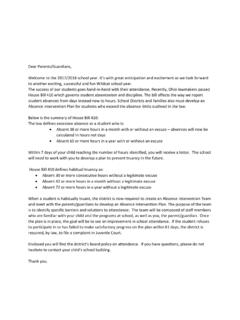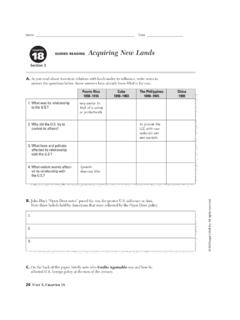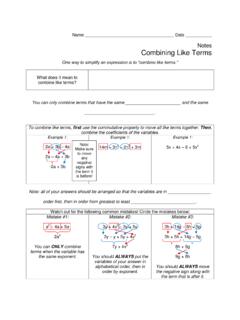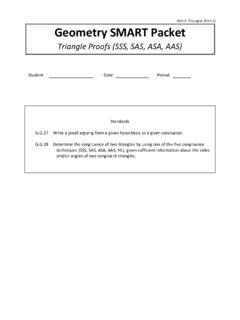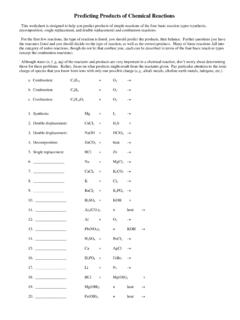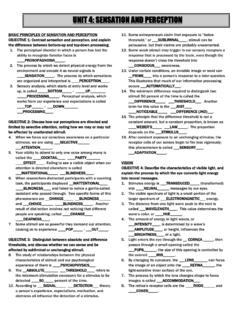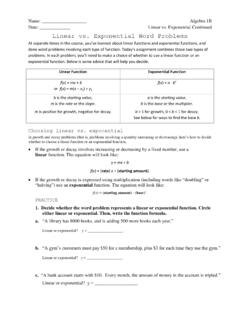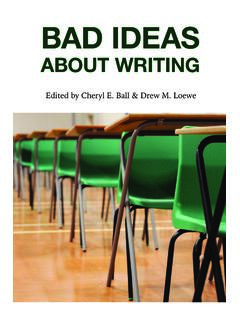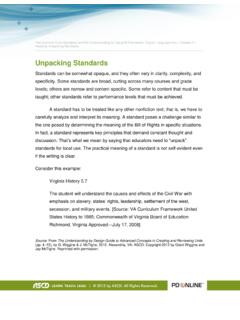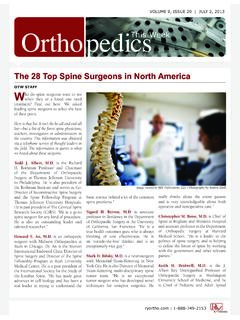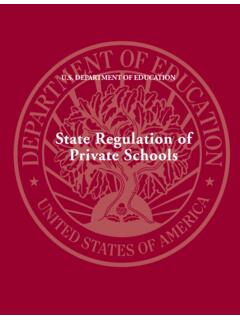Transcription of FORTY STUDIES PSYCHOLOGY
1 FORTY STUDIES THAT CHANGED PSYCHOLOGY L FORTY STUDIES THAT CHANGED PSYCHOLOGY Explorations into the History of Psychological Research Sixth Edition Roger R. Hock, Mendocino College Pearson education International VP/Editorial Director: Leah Jewell Executive Editor/Project Manager: Jessica Mosher Editorial Assistant: Amanda Bacher Associate Managing Editor: Maureen Richardson Production Liaison: Shelly Kupperman Senior Operations Supervisor: Sherry Lewis Director of Marketing: Brandy Dawson Senior Marketing Manager: Kate Mitchell Marketing Assistant: Jennifer Lang AV Project Manager: Maria Piper Associate Supplements Editor: Virginia Livsey Director, Cover Design: Jayne Conte Cover Designer.
2 Studio Indigo Cover Image: Getty Images, Inc. Composition and Full-Service Project Management: Aptara, Lamba Printer/Binder: Donnelley & Sons Cover Printer: Phoenix Color Corp. Credits and acknowledgments borrowed from other sources and reproduced, with permission, in this textbook appear on the appropriate page of appearance within text. If you purchased this book within the United States or Canada you should be aware that it has been wrongfully imported without the approval of the Publisher or the Author. Copyright 2009, 2005, 2002, 1999, 1996 by Pearson education , Inc.
3 , Upper Saddle River, New Jersey, 07458. All rights reserved. Printed in the United States of America. This publication is protected by Copyright and permission should be obtained from the publisher prior to any prohibited reproduction, storage in a retrieval system, or transmission in any form or by any means, electronic, mechanical, photocopying, recording, or likewise. For information regarding permission(s), write to: Rights and Permissions Department. Pearson Prentice Hall is a trademark of Pearson education , Inc. Pearson* is a registered trademark of Pearson pic Prentice Hall* is a registered trademark of Pearson education , Inc.
4 Pearson education Ltd., London Pearson education North Asia Ltd., Hong Kong Pearson education Singapore, Pte. Ltd Pearson Educaci n de Mexico, de CV. Pearson education Canada, Inc. Pearson education Malaysia, Pte. Ltd. Pearson education -Japan Pearson education Upper Saddle River, New Jersey Pearson education Australia PTY, Limited PEARSON 10 9 8 7 6 5 4 ISBN-13: 17 -D-13-S0M507-7 ISBN-ID: G-13-5tmsa7-X For Diane Perin Hock and Caroline Mei Perin Hock CONTENTS PREFACE xi CHAPTER I BIOLOGY AND HUMAN BEHAVIOR 1 READING 1: ONE BRAIN OR TWO?
5 1 Gazzaniga, M. S. (1967). The split brain in man. Scientific American, 217(2), 24-29. READING 2: MORE EXPERIENCE = BIGGER BRAIN 11 Rosenzweig, M. R., Bennett, E. L., & Diamond, M. C. (1972). Brain changes in response to experience. Scientific American, 226(2), 22-29. READING 3: ARE YOU A "NATURAL?" 19 Bouchard, T., Lykken, D., McGue, M., Segal, N., & Tellegen, A. (1990). Sources of human psychological differences: The Minnesota study of twins reared apart. Science, 250, 223-229. READING 4: WATCH OUT FOR THE VISUAL CLIFF! 27 Gibson, E.
6 J., & Walk, R. D. (1960). The "visual cliff." Scientific American, 202(4), 67-71. CHAPTER II PERCEPTION AND CONSCIOUSNESS 35 READING 5: TAKE A LONG LOOK 36 Fantz, R. L. (1961). The origin of form perception. Scientific American, 204(May), 61-72. READING 6: TO SLEEP, NO DOUBT TO DREAM .. 42 Aserinsky, E., & Kleitman, N. (1953). Regularly occurring periods of eye mobility and concomitant phenomena during sleep. Science, 118, 273-274. Dement, W. (1960). The effect of dream deprivation. Science, 131, 1705-1707. READING 7: UNROMANCING THE DREAM 49 Hobson, J.
7 A., & McCarley, R. W. (1977). The brain as a dream-state generator: An activation-synthesis hypothesis of the dream process. American Journal of Psy-chiatry, 134, 1335-1348. READING 8: ACTING AS IF YOU ARE HYPNOTIZED 56 Spanos, N. R (1982). Hypnotic behavior: A cognitive, social, psychological per-spective. Research Communications in PSYCHOLOGY , Psychiatry, and Behavior, 7, 199-213. vii viii Contents CHAPTER III LEARNING AND CONDITIONING 65 READING 9: IT'S NOT JUST ABOUT SALIVATING DOGS! 65 Pavlov, I. P. (1927). Conditioned reflexes.
8 London: Oxford University Press. READING 10: LITTLE EMOTIONAL ALBERT 72 Watson, J. B., & Rayner, R. (1920). Conditioned emotional responses. Journal of Experimental PSYCHOLOGY , 3, 1-14. READING 11: KNOCK WOOD! 78 Skinner, B. F. (1948). Superstition in the pigeon. Journal of Experimental Psychol-ogy, 38, 168-172. READING 12: SEE AGGRESSION .. DO AGGRESSION! 85 Bandura, A., Ross, D., & Ross, S. A. (1961). Transmission of aggression through im-itation of aggressive models. Journal of Abnormal and Social PSYCHOLOGY , 63, 575-582. CHAPTER IV INTELLIGENCE, COGNITION, AND MEMORY 93 READING 13: WHAT YOU EXPECT IS WHAT YOU GET 93 Rosenthal, R.
9 , & Jacobson, L. (1966). Teachers' expectancies: Determinates of pupils' IQ gains. Psychological Reports, 19, 115-118. READING 14: JUST HOW ARE YOU INTELLIGENT? 100 Gardner, H. (1983) Frames of mind: The theory of multiple intelligences. New York: Basic Books. READING 15: MAPS IN YOUR MIND 110 Tolman, E. C. (1948). Cognitive maps in rats and men. Psychological Review, 55, 189-208. READING 16: THANKS FOR THE MEMORIES! 11 7 Loftus, E. F. (1975). Leading questions and the eyewitness report. Cognitive Psy-chology, 7, 560-572. CHAPTER V HUMAN DEVELOPMENT 126 READING 17: DISCOVERING LOVE 126 Harlow, H.
10 F. (1958). The nature of love. American Psychologist, 13, 673-685. READING 18: OUT OF SIGHT, BUT NOT OUT OF MIND 1 34 Piaget, J. (1954). The development of object concept. In J. Piaget, The construc-tion of reality in the child (pp. 3-96). New York: Basic Books. READING 19: HOW MORAL ARE YOU? 143 Kohlberg, L. (1963). The development of children's orientations toward a moral order: Sequence in the development of moral thought. Vita Humana, 6, 11-33. READING 20: IN CONTROL AND GLAD OF IT! 150 Langer, E. J., & Rodin, J. (1976). The effects of choice and enhanced personal responsibility for the aged: A field experiment in an institutional setting.

